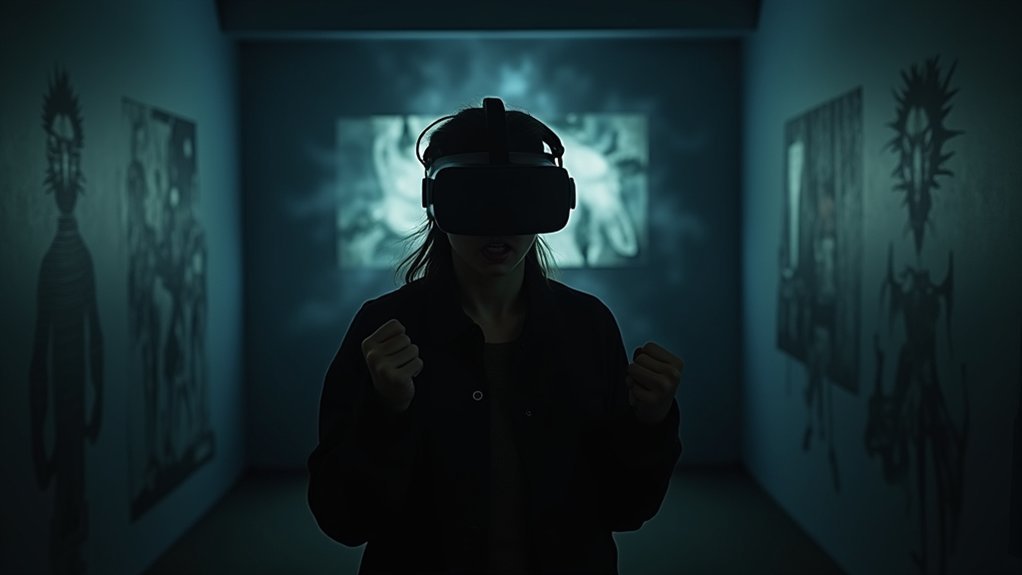Your brain responds to VR field of view through three key mechanisms that fundamentally alter your digital experience. Wide FOV settings (110°+) enhance your sense of agency and control while reducing fear responses, creating comfortable immersion. Standard FOV (90-110°) balances emotional arousal with presence. Narrow or restricted FOV dramatically amplifies fear and vulnerability by triggering primal psychological responses, though it risks cybersickness. These visual boundaries directly shape how you’ll process emotions, perceive control, and experience psychological immersion in virtual environments.
Visual Realism and FOV Interactions Shape Emotional Processing

When you experience virtual reality, the interplay between visual realism and field of view creates a powerful combination that directly shapes how your brain processes emotions. Your emotional processing intensifies when these technical elements work together, particularly during heightened emotional arousal states.
A broader view combined with enhanced visual realism doesn’t just improve your user experience—it fundamentally alters how you perceive and react to the virtual environment.
The FoV you’re exposed to directly influences your sense of presence, especially when fear amplifies your responses. In immersive virtual reality, your emotional state moderates how these visual factors affect you.
Field of view shapes your immersion, while fear and emotional states determine how powerfully these visual elements impact your virtual experience.
Human factors research reveals that this interaction creates a feedback loop where technical specifications and emotional responses continuously influence each other, determining your overall immersive experience.
Agency Perception Changes Under Different Field of View Settings
Beyond emotional processing, your perception of agency—your sense of control and influence over virtual environments—shifts dramatically based on field of view configurations.
When FoV settings are optimized, you’ll experience heightened immersion and emotional engagement, particularly during intense scenarios. However, poorly calibrated FoV can compromise your user experience through reduced perceived realism and comfort issues.
The design process must consider three critical FoV impacts on agency:
- Wide FoV enhances your feeling of control and presence in virtual environments
- Narrow FoV constrains your sense of agency, creating feelings of limitation
- Extreme FoV settings can trigger cybersickness, undermining your overall experience
Designers who understand these agency-FoV relationships create more engaging virtual experiences that maximize your sense of control while maintaining comfort throughout extended VR sessions.
Fear Response Amplification Through Restricted Visual Boundaries

While your sense of agency shapes control perception, restricted field of view settings trigger more primal psychological responses by amplifying fear through constrained visual boundaries. When you experience limited Field of View (FoV) in virtual reality (VR), your fear response intensifies dramatically. The TAP-Fear model demonstrates that these emotions enhance presence, creating a more immersive experience through heightened anxiety and discomfort.
| FoV Setting | Fear Response Level | User Experience Quality |
|---|---|---|
| Wide (110°+) | Low | Comfortable, reduced confinement |
| Standard (90-110°) | Moderate | Balanced emotional arousal |
| Narrow (70-90°) | High | Increased anxiety, vulnerability |
| Restricted (<70°) | Very High | Maximum discomfort, claustrophobia |
Your visual boundaries directly affect emotional arousal—narrower perspectives create vulnerability feelings that amplify fear-inducing scenarios, making restricted FoV a powerful tool for immersive psychological experiences.
Frequently Asked Questions
What Is a Good Fov for VR?
You’ll want a field of view between 90-110 degrees for most VR headsets. This range provides good immersion without causing motion sickness. Higher-end models can exceed 120 degrees for enhanced realism.
What Are the Side Effects of VR on the Brain?
VR can cause your brain to experience disorientation, nausea, and eye strain due to conflicting signals between visual and vestibular systems. You’ll potentially develop postural instability and cybersickness symptoms.
What Is the Effect of a Foveated Field of View Restrictor on VR Sickness?
You’ll experience considerably reduced VR sickness symptoms like nausea when using foveated FOV restrictors. They dynamically adjust your field of view during movement, keeping you comfortable without noticing the changes happening.
What Is the Negative Effect of Virtual Reality Headsets?
You’ll experience cybersickness when using VR headsets, including nausea, eye strain, and disorientation. These symptoms can cause cold sweats and vomiting, making you reluctant to use VR technology again.





Leave a Reply